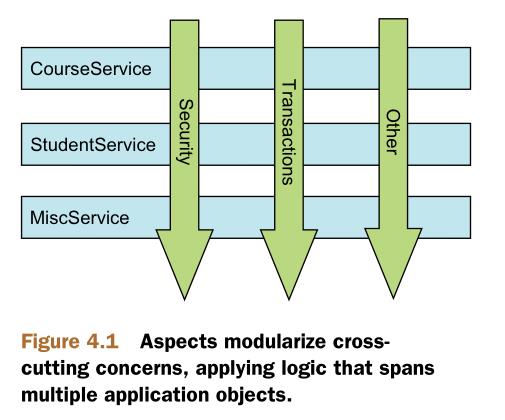SPRING IN ACTION 第4版笔记-第四章Aspect-oriented Spring-001-什么是AOP
Posted shamgod
tags:
篇首语:本文由小常识网(cha138.com)小编为大家整理,主要介绍了SPRING IN ACTION 第4版笔记-第四章Aspect-oriented Spring-001-什么是AOP相关的知识,希望对你有一定的参考价值。
一、
Aspect就是把会在应用中的不同地方重复出现的非业务功能的模块化,比如日志、事务、安全、缓存

In software development, functions that span multiple points of an application are
called cross-cutting concerns. Typically, these cross-cutting concerns are conceptually
separate from (but often embedded directly within) the application’s business logic.
Separating these cross-cutting concerns from the business logic is where aspect-
oriented programming ( AOP ) goes to work.
DI helps you decouple application objects from
each other, AOP helps you decouple cross-cutting concerns from the objects they
affect.
Logging is a common example of the application of aspects, but it’s not the only
thing aspects are good for. Throughout this book, you’ll see several practical applica-
tions of aspects, including declarative transactions, security, and caching.
aspects help to modularize cross-cutting concerns. In short, a cross-
cutting concern can be described as any functionality that affects multiple points of an
application. Security, for example, is a cross-cutting concern, in that many methods in
an application can have security rules applied to them. Figure 4.1 gives a visual depic-
tion of cross-cutting concerns.
This figure represents a typical application that’s broken down into modules.
Each module’s main concern is to provide services for its particular domain. But each
module also requires similar ancillary functionality, such as security and transaction
management.
A common object-oriented technique
for reusing common functionality is to
apply inheritance or delegation. But inheri-
tance can lead to a brittle object hierarchy
if the same base class is used throughout an
application, and delegation can be cumber-
some because complicated calls to the dele-
gate object may be required.
Aspects offer an alternative to inheri-
tance and delegation that can be cleaner in
many circumstances. With AOP , you still
define the common functionality in one
place, but you can declaratively define how and where this functionality is applied
without having to modify the class to which you’re applying the new feature. Cross-
cutting concerns can now be modularized into special classes called aspects. This has
two benefits. First, the logic for each concern is in one place, as opposed to being scat-
tered all over the code base. Second, your service modules are cleaner because they
only contain code for their primary concern (or core functionality), and secondary
concerns have been moved to aspects.
以上是关于SPRING IN ACTION 第4版笔记-第四章Aspect-oriented Spring-001-什么是AOP的主要内容,如果未能解决你的问题,请参考以下文章
SPRING IN ACTION 第4版笔记-第四章ASPECT-ORIENTED SPRING-010-Introduction为类增加新方法
SPRING IN ACTION 第4版笔记-第四章ASPECT-ORIENTED SPRING-006-定义切面使用xml
SPRING IN ACTION 第4版笔记-第四章ASPECT-ORIENTED SPRING-007-定义切面的around advice
SPRING IN ACTION 第4版笔记-第四章ASPECT-ORIENTED SPRING-009-带参数的ADVICE2 配置文件为XML
SPRING IN ACTION 第4版笔记-第三章ADVANCING WIRING-008-SpEL介绍
SPRING IN ACTION 第4版笔记-第三章ADVANCING WIRING-005-Bean的作用域@ScopeProxyMode